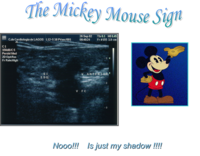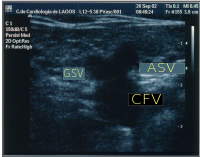
Summary
Mickey Mouse sign is a medical sign resembling the head of Mickey Mouse, the Walt Disney character. Presented for the very first time at the CHIVA's Meeting, Berlin 2002 by Dr. Lurdes Cerol,[citation needed] this sign has been described as the image at the groin when a dilated accessory saphenous vein (ASV) exists: the common femoral vein (CFV) represents the head of Mickey Mouse while the great saphenous vein (GSV) and the dilated accessory saphenous vein (ASV) represent the ears. The presence of a Mickey Mouse sign has been a great diagnostic clue to check ASV insufficiency.


Some authors, inspired by this sign, described an ecographic "Mickey Mouse View" at the saphenofemoral junction in the groin: the common femoral vein (CFV) represents the head of Mickey Mouse while the great saphenous vein (GSV) and the accessory saphenous vein (ASV) represent the ears.[1]
But it can be seen in different regions of the body:
- Midbrain of progressive supranuclear palsy (PSP).[2]
- Polyostotic Paget's disease (Paget's disease affecting multiple bones); a bone scintigraphy with technetium-99m methylene bisphosphonate shows increased uptake at the sites of disease activity. Increased scintigraphic uptake in the body and spine of the vertebrae resembles the head of Mickey Mouse.[3]
- The portal triad in biliary ultrasound scans, with the portal vein comprising Mickey's head and the common bile duct and hepatic artery his right and left ears, respectively.[4]
- Pelvic Mickey Mouse sign: bilateral inguinal vesical hernia on transverse axial imaging.[5]
- Dysmorphic Mickey Mouse RBCs: RBCs with irregular cell walls and migration of hemoglobin into some areas creating the shape of Mickey Mouse ears.[6] The presence of these dysmorphic cells in urine may indicate intraglomerular haemorrhage.[7]
- Ureteropelvic junction obstruction (UPJO)[8]
References edit
- ^ Coleridge-Smith P, Labropoulos N, Partsch H, Myers K, Nicolaides A, Cavezzi A (January 2006). "Duplex ultrasound investigation of the veins in chronic venous disease of the lower limbs--UIP consensus document. Part I. Basic principles". European Journal of Vascular and Endovascular Surgery. 31 (1): 83–92. doi:10.1016/j.ejvs.2005.07.019. PMID 16226898.
- ^ Sonthalia N, Ray S (September 2012). "The Hummingbird sign: a diagnostic clue for Steele-Richardson-Olszweski syndrome". BMJ Case Reports. 2012: bcr2012006263. doi:10.1136/bcr-2012-006263. PMC 4543120. PMID 22987902.
- ^ Goyal A, Boro H (November 2017). "Mickey Mouse sign in a case of polyostotic Paget's disease". Indian Journal of Case Reports. 3 (4): 279–80. doi:10.32677/IJCR.2017.v03.i04.038.
- ^ Fox, J. Christian (2011-10-13). Atlas of Emergency Ultrasound. Cambridge University Press. ISBN 9781139499873.
- ^ Singh O, Kekre NS (2017). ""Flying-saucer in the pelvis" sign: An equivalent of "pelvic Mickey mouse" sign". Indian Journal of Urology. 33 (2): 173–174. doi:10.4103/0970-1591.203423. PMC 5396411. PMID 28469311.
- ^ Kher, Kanwal; Schnaper, H. William; Greenbaum, Larry A. (2016-11-25). Clinical Pediatric Nephrology. CRC Press. ISBN 9781482214635.
- ^ McClatchey, Kenneth D. (2002). Clinical Laboratory Medicine. Lippincott Williams & Wilkins. ISBN 9780683307511.
- ^ Visveswaran, kasi (2009). Essentials of Nephrology, 2/e. BI Publications Pvt Ltd. ISBN 9788172253233.


